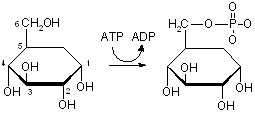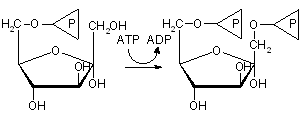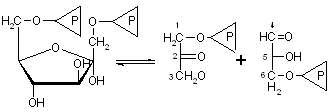| navigation: | Home | Copyright | Contact us | | |

|
|
Enzymes:
1. Hexokinase
2. Phosphoglucoisomerase
3. Phosphofructokinase
4. Aldolase
5. Triose phosphate isomerase
6. Glyceraldehyde-3-phosphate dehydrogenase
7. Phosphoglycerate kinase
8. Phosphoglycerate mutase
9. Enolase
10. Pyruvate kinase
Compounds:
ATP
ADP
Glucose
Pyruvate
Glycolysis
published: 21 Nov 2011 (3:12)
Glycolysis, an overview
Glycolysis (a sweet splitting process) is a central pathway for the catabolism of carbohydrates in which the six-carbon sugars are split to three-carbon compounds with subsequent release of energy used to transform ADP to ATP. Glycolysis can proceed under anaerobic (without oxygen) and aerobic conditions.Why the glycolysis, is the most interesting pathway for studies? First of all, this pathway is almost universal across all living organisms, and therefore all proteins or enzymes which are involved in catalysis are very similar across all organisms. Secondly, glycolysis is one of the ancient metabolic pathways in living cells. Finally, glycolysis is the first pathway which was studied in detail.
Glycolysis, an overall equation
Glycolysis is a 10-step pathway which converts glucose to 2 pyruvate molecules. The overall Glycolysis step can be written as a net equation:Glucose + 2xADP + 2xNAD+ -> 2xPyruvate + 2xATP + 2xNADH
Glycolysis consists from two main phases. First phase, energy investment. During this step 2xATP are converted to 2xADP molecules. Second phase, energy generation. During this step 4xADP are converted to 2xATP molecules and 2xNAD+ are converted to 2xNADH molecules.
Diagram of Glycolysis pathway
Glycolysis: Energy investment phase | |||
| Glycolysis step 1: Glucose phosphorylation catalysed by Hexokinase: α-D-Glucose + ATP -> α-D-Glucose-6-phosphate + ADP + H+ δGo = -16.7 kJ/mol | ||
| Glycolysis step 2: Isomerization of glucose-6-phosphate catalysed by Phosphoglucoisomerase: α-D-Glucose-6-phosphate <=> D-Fructose-6-phosphate δGo = +1.7 kJ/mol | ||
| Glycolysis step 3: Second phosphorylation catalysed by Phosphofructokinase: D-Fructose-6-phosphate + ATP -> D-Fructose-1,6-bisphosphate + ADP + H+ δGo = -18.5 kJ/mol | ||
| Glycolysis step 4: Cleavage to two Triose phosphates catalysed by Aldolase: D-Fructose-1,6-bisphosphate <=> Dihydroxyacetone phosphate + D-glyceroaldehyde-3-phosphate δGo = +28 kJ/mol | ||
| Glycolysis step 5: Isomerization of dihydroxyacetone phosphate catalysed by Triose phosphate isomerase: Dihydroxyacetone phosphate <=> D-glyceroaldehyde-3-phosphate δGo = +7.6 kJ/mol | ||
Glycolysis: Energy generation phase | |||
| Glycolysis step 6: Generation of 1,3-Bisphosphoglycerate catalysed by Glyceraldehyde-3-phosphate dehydrogenase: D-glyceroaldehyde-3-phosphate + NAD+ +Pi <=> 1,3-Bisphosphoglycerate + NADH + H+ δGo = +6.3 kJ/mol | ||
| Glycolysis step 7: Substrate-level phosphorylation, 3-Phosphoglycerate catalysed by Phosphoglycerate kinase: 1,3-Bisphosphoglycerate + ADP <=> 3-Phosphoglycerate + ATP δGo = -18.8 kJ/mol | ||
| Glycolysis step 8: Phosphate transfer to 2-Phosphoglycerate catalysed by Phosphoglycerate mutase: 3-Phosphoglycerate <=> 2-Phosphoglycerate δGo = +4.4 kJ/mol | ||
| Glycolysis step 9: Synthesis of Phosphoenolpyruvate catalysed by Enolase: 2-Phosphoglycerate <=> Phosphoenolpyruvate + H2O δGo = +1.7 kJ/mol | ||
| Glycolysis step 10: Substrate-level phosphorylation. Pyruvate synthesis catalysed by Pyruvate kinase: Phosphoenolpyruvate + H+ + ADP -> Pyruvate + ATP δGo = -31.4 kJ/mol | ||
Anaerobic and Aerobic Glycolysis
Glycolysis is an ancient metabolic pathway which was probably developed about 3.5 billion years ago when there is no oxygen was available. That is why main Glycolysis Glycolysis step s are not require oxygen. Products from Glycolysis then can follow anaerobic and aerobic pathways.Anaerobic Glycolysis pathway
For anaerobic Glycolysis pathway there are two major fermentation processes exists.Lactic acid fermentation. This pathway is common for animal cells and lactic acid bacteria. In animals the anaerobic glycolysis take place in many tissues. Red blood cells take most of the energy from anaerobic metabolism. Skeletal muscle take energy from glycolysis and from respiration. The lactate produced utilise through diffusion from the tissues to bloodstream and then to aerobic tissues, such as liver and heart. In these aerobic tissues lactate can be catabolized further or can be converted back through gluconeogenesis.
| One step conversion of Pyruvate to Lactate catalysed by Lactate dehydrogenase. δGo = -25.1 kJ/mol | |
| Alcoholic fermentation. This two-step pathway is common for yeast. | ||
| Pyruvate -> Acetaldehyde + CO2 catalysed by Pyruvate decarboxylase. This reaction requires thiamine pyrophosphate, derived from vitamin B1 as a coenzyme. | |
| Conversion of Acetaldehyde to Ethanol by Alcohol dehydrogenase. | |
Aerobic Glycolysis pathway
With the present of oxygen in cells pyruvate is oxidized to acetyl-CoA, which then enters the citric acid cycle. The NADH molecules are reoxidized through the with electrons transferred to the O2 molecules. The aerobic Glycolysis consists from two major steps:Glucose + 2xADP + 2xPi + 2xNAD+ =>
2xPyruvate + 2xATP + 2xNADH + 2H+ + 2xH2O
NADH oxidation pathway which generaly take place in the mitochohdrion:
2xNADH + 8xH+ + O2 + 6xADP + 6xPi =>
2xNAD+ + 8H2O + 6xATP
The final net equation for aerobic Glycolysis:
Glucose + 8xADP + 8xPi + 8xH+ + O2 => 2xPyruvate + 8xATP + 10xH2O
Aerobic and anaerobic glycolysis. Overview
The metabolism of glucose trough aerobics or anaerobic pathways is a nonoxidative process. Both types of glycolysis release a small fraction of potential energy stored in the glucose molecules. During the first 10 steps of glycolysis, only a small part of all glucose energy is released and the rest of the potential energy is released during the last steps after glycolysis. For this reason aerobic degradation is much more efficient than anaerobic metabolism. That is why the aerobic mechanism is now much more spread within living organisms, but nevertheless anaerobic pathways still take place even in animals under certain physiological circumstances.News
Inhibit Glycolysis to Starve Tumour CellsThe multi-system disease called Tuberous ...
Glycolysis Role in RhabdomyosarcomasA study conducted by the IDIBELL researchers ...
Other news pages:
1
| Copyright 2007-... by Glycolysis.co.uk |













